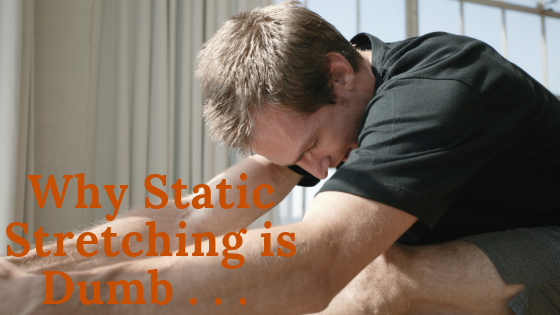Yep, static stretching is dumb and sucks large moose balls, and I have not changed my mind on it.
In fact, after 4 days of fresh tissue cadaver dissection here in AZ with Tom Myers, I am even more convinced it is a waste of time and may make you worse.
Not only does a prolonged static stretch REDUCE muscle power, I can’t figure out why it is called “muscle” stretching since while you are pulling on the muscle, you are pulling on everything else too.
In fact, you are pulling (stretching) a whole group of muscles as they are all attached to EACH OTHER via fascia (think – connective tissue).
Imagine you Saran wrapped each muscle and then started saran wrapping groups of them together. You are getting close to how static stretching looks. Do that many more times and you are closer yet.
The past 2 days, I spent about 8 hours dissecting out the quads and hamstring compartments.
Why so long (other than I am a slow dissector)? Most of that time was spent cutting away all the fascia and other tissue! It is everywhere. Literally everywhere.
When you put a “muscle” into a stretch position, you are pulling on all of that tissue plus tissue that is even farther away. That farther away tissue is connected too.
Do this: move your right arm all the way out to your side and allow your hips to rotate back. Where did you feel it? I am willing to bet you felt it all the way in your opposite hip and maybe into your leg/knee or ankle.
If you held that position, what “muscle” are you stretching?
Also, I think measuring flexibility changes is a bit of a goofy endpoint. I would be much more interested in STRENGTH at the END RANGE. Who cares if you can get 1 more inch, especially if you are super weak in that new range of motion.
The main effect seems to be a change in PERCEPTION of how far you can push in say a seated toe reach (http://ptjournal.apta.org/content/90/3/438) . More static stretching allows you to push further because there is less pain/tension/feedback. That sounds like a bad idea to me.
What to do
I am a much bigger fan of active mobility, since it has a much higher strength component to it. You are also working on more inhibition of other muscles to get into that position along with better coordination.
Do some type of movement-based mobility instead.
For example, strength training done to your own range of motion and then back. RDLs for hamstrings are a great example. They must be slowly progressive, of course, but they have the hamstrings under load to the end range, and then you have to REVERSE that load. Over time I would add speed to it (and load of course).
Adios, static stretching,
Dr Mike Nelson
References:
Avela J., H. Kyrolainen, P. V. Komi. Altered reflex sensitivity after repeated and prolonged passive muscle stretching. J Appl Physiol. 86(4):1283-1291, 1999.
Behm D. G., D. C. Button, J. C. Butt. Factors affecting force loss with prolonged stretching. Can J Appl Physiol. 26(3):261-272, 2001..
Church J. B., M. S. Wiggins, F. M. Moode, R. Crist. Effect of warm-up and flexibility treatments on vertical jump performance. J Strength Cond Res. 15(3):332-336, 2001.
Cornwell A., A. G. Nelson, B. Sidaway. Acute effects of stretching on the neuromechanical properties of the triceps surae muscle complex. Eur J Appl Physiol. 86(5):428-434, 2002.
Cramer J. T., T. J. Housh, G. O. Johnson, J. M. Miller, J. W. Coburn, T. W. Beck. Acute effects of static stretching on peak torque in women. J Strength Cond Res. 18(2):236-241, 2004.
Cramer J. T., T. J. Housh, J. P. Weir, G. O. Johnson, J. W. Coburn, T. W. Beck. The acute effects of static stretching on peak torque, mean power output, electromyography, and mechanomyography. Eur J Appl Physiol. 93(5-6):530-539, 2005.
Evetovich T. K., N. J. Nauman, D. S. Conley, J. B. Todd. Effect of static stretching of the biceps brachii on torque, electromyography, and mechanomyography during concentric isokinetic muscle actions. J Strength Cond Res. 17(3):484-488, 2003.
Faigenbaum A. D., M. Bellucci, A. Bernieri, B. Bakker, K. Hoorens. Acute effects of different warm-up protocols on fitness performance in children. J Strength Cond Res. 19(2):376-381, 2005.
Fletcher I. M., R. Anness. The acute effects of combined static and dynamic stretch protocols on fifty-meter sprint performance in track-and-field athletes. J Strength Cond Res. 21(3):784-787, 2007.
Fletcher I. M., B. Jones. The effect of different warm-up stretch protocols on 20 meter sprint performance in trained rugby union players. J Strength Cond Res. 18(4):885-888, 2004.
Fowles J. R., D. G. Sale, J. D. MacDougall. Reduced strength after passive stretch of the human plantarflexors. J Appl Physiol. 89(3):1179-1188, 2000.
Knudson D., K. Bennett, R. Corn, D. Leick, C. Smith. Acute effects of stretching are not evident in the kinematics of the vertical jump. J Strength Cond Res. 15(1):98-101, 2001.
Marek S. M., J. T. Cramer, A. L. Fincher, et al. Acute Effects of Static and Proprioceptive Neuromuscular Facilitation Stretching on Muscle Strength and Power Output. J Athl Train. 40(2):94-103, 2005.
Nelson A. G., N. M. Driscoll, D. K. Landin, M. A. Young, I. C. Schexnayder. Acute effects of passive muscle stretching on sprint performance. J Sports Sci. 23(5):449-454, 2005.
Nelson A. G., I. K. Guillory, C. Cornwell, J. Kokkonen. Inhibition of maximal voluntary isokinetic torque production following stretching is velocity-specific. J Strength Cond Res. 15(2):241-246, 2001.
Power K., D. Behm, F. Cahill, M. Carroll, W. Young. An acute bout of static stretching: effects on force and jumping performance. Med Sci Sports Exerc. 36(8):1389-1396, 2004.
Wallmann H. W., J. A. Mercer, J. W. McWhorter. Surface electromyographic assessment of the effect of static stretching of the gastrocnemius on vertical jump performance. J Strength Cond Res. 19(3):684-688, 2005.
Weir D. E., J. Tingley, G. C. Elder. Acute passive stretching alters the mechanical properties of human plantar flexors and the optimal angle for maximal voluntary contraction. Eur J Appl Physiol. 93(5-6):614-623, 2005.g





Leave A Comment